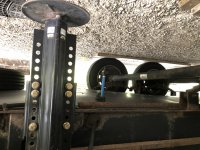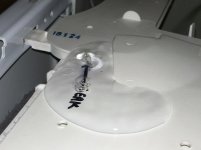Just purchased a used one year old (2019) Big Country 3155 RV. The manual talks about the "Low Point Drains) when winterizing. I only find one drain valve, which is on the fresh water tank. The dealer I purchased from was surprised that there were no low point drains. Do other recent Big Country owners find theirs do not have the low point drains?
- Home
- Forums
- HEARTLAND RVs GENERAL AREA
- Plumbing - For all Heartland brands
- Faucets, Sinks, Showers, Fresh Water Tanks, Valves
You are using an out of date browser. It may not display this or other websites correctly.
You should upgrade or use an alternative browser.
You should upgrade or use an alternative browser.
Low point drains
- Thread starter jstauffer
- Start date
danemayer
Well-known member
Hi jstauffer,
Welcome to the Heartland Owners Forum.
The Heartland manual is pretty generic and covers many models and floor plans. But Landmark, Bighorn, and Big Country haven't had low point drains for many years. They're rated for full-time living and in colder weather, low point drains can freeze and the ice may block the water feed lines.
For winterizing help, take a look at our owner-written Winterization Guide.
Welcome to the Heartland Owners Forum.
The Heartland manual is pretty generic and covers many models and floor plans. But Landmark, Bighorn, and Big Country haven't had low point drains for many years. They're rated for full-time living and in colder weather, low point drains can freeze and the ice may block the water feed lines.
For winterizing help, take a look at our owner-written Winterization Guide.
Thanks danemayer for that info. Yes the Heartland manual is VERY generic in many areas. Our last camper did have the low point drains with a winter package. And, I liked the low point drain as I felt if we were not staying in the camper and the temps were to get down to just around the freezing area by just draining the tanks & low point drains I would be safe.
mlpeloquin
Well-known member
To drain the system, remove the water heater drain plug.
This will only drain the hot water heater. If you get an adapter that attaches your compressor to the water heater, you can blow out all your lines one fitting at a time. If you have a washer/dryer hookups, you need to blow them out as well.
There is a blue line that hangs down under the rig, its the fresh water tank drain. As others have mentioned heartland doesnt do low point drains anymore on these series of RV's. Dont forget to winterize your outside shower fixture, thats one I always seem to forget, as I never use it.
Attachments
Gary521
Well-known member
Even if you had low point drains you would have to do this IF you were relying on this just to winterize.This will only drain the hot water heater. If you get an adapter that attaches your compressor to the water heater, you can blow out all your lines one fitting at a time. If you have a washer/dryer hookups, you need to blow them out as well.
JohnDar
Prolifically Gabby Member
If you have a washer installed in your rig, blowing with air will not winterize it. You must pump antifreeze through it per the instructions. I learned the hard way on that. This is the Water Distribution Assembly inside a Splendide combo unit. The leak wasn't noticed until the machine was used again and water was dripping off the king pin. Also forced the installation of a drip pan w/drain...after the fact.
If you have a city water inlet, connect the compressor adapter to that and you can blow out everything else. If you remove the water heater anode on a Suburban water heater, don't stand in front of it when you turn on the air.
If you have a city water inlet, connect the compressor adapter to that and you can blow out everything else. If you remove the water heater anode on a Suburban water heater, don't stand in front of it when you turn on the air.
Attachments
This will only drain the hot water heater. If you get an adapter that attaches your compressor to the water heater, you can blow out all your lines one fitting at a time. If you have a washer/dryer hookups, you need to blow them out as well.
Would this not blow water heater sediments back into the system?
The reason I thought low drain plugs would be convenient is that we live in Las Vegas (unfortunately) and for the most part will be traveling in areas where if it gets below freezing it will be only a few degrees typicall towards morning. Most people here do not winterize including RV dealerships, but I do (Grew up and lived most of my life in areas that did freeze big time so don't want to take the chance.) Ether by pumping in RV antifreeze or blowing out. But for those times we are putting it in storage for a few days during the winter it would be nice to just open low point drains and then would probably be safe unless it was a hard freeze.
I used to be able to take our RV to our home to blow out with my larger compressor but do to some HOA rules I can no longer do that. So, have purchased a pancake compressor to blow the RV lines out prior to leaving the last campsite before storage. That is if the forecast is for freezing temps.
We do have a washer & dryer and will have to get the instructions out but thought I had read somewhere that said if you blow out your lines you can still put some antifreeze in the tub and by pressing certain buttons, it will winterize the washer.
Thanks for the help guys.
mlpeloquin
Well-known member
Would this not blow water heater sediments back into the system?
The reason I thought low drain plugs would be convenient is that we live in Las Vegas (unfortunately) and for the most part will be traveling in areas where if it gets below freezing it will be only a few degrees typicall towards morning. Most people here do not winterize including RV dealerships, but I do (Grew up and lived most of my life in areas that did freeze big time so don't want to take the chance.) Ether by pumping in RV antifreeze or blowing out. But for those times we are putting it in storage for a few days during the winter it would be nice to just open low point drains and then would probably be safe unless it was a hard freeze.
I used to be able to take our RV to our home to blow out with my larger compressor but do to some HOA rules I can no longer do that. So, have purchased a pancake compressor to blow the RV lines out prior to leaving the last campsite before storage. That is if the forecast is for freezing temps.
We do have a washer & dryer and will have to get the instructions out but thought I had read somewhere that said if you blow out your lines you can still put some antifreeze in the tub and by pressing certain buttons, it will winterize the washer.
Thanks for the help guys.
You should always flush the water heater out to remove the sediments. The Drain is at the bottom and the output is at the backside top. When empty of water and filled with air, sediments, if any, will stay at the bottom. Follow the instructions for the washer and then disconnect the water lines. Hookup a garden hose and blow out the lines. If you put antifreeze in the water system, it will be in the washer PEX lines as well.
danemayer
Well-known member
Would this not blow water heater sediments back into the system?
The reason I thought low drain plugs would be convenient is that we live in Las Vegas (unfortunately) and for the most part will be traveling in areas where if it gets below freezing it will be only a few degrees typicall towards morning. Most people here do not winterize including RV dealerships, but I do (Grew up and lived most of my life in areas that did freeze big time so don't want to take the chance.) Ether by pumping in RV antifreeze or blowing out. But for those times we are putting it in storage for a few days during the winter it would be nice to just open low point drains and then would probably be safe unless it was a hard freeze.
I used to be able to take our RV to our home to blow out with my larger compressor but do to some HOA rules I can no longer do that. So, have purchased a pancake compressor to blow the RV lines out prior to leaving the last campsite before storage. That is if the forecast is for freezing temps.
We do have a washer & dryer and will have to get the instructions out but thought I had read somewhere that said if you blow out your lines you can still put some antifreeze in the tub and by pressing certain buttons, it will winterize the washer.
Thanks for the help guys.
When we lived in central Texas, I used compressed air, which quickly winterized the trailer. I did put some antifreeze in the washer drum and ran the drain cycle, and put antifreeze in each trap. In the relatively mild winters of central Texas, that was good enough - didn't have a problem with the washer. But we're now in Colorado and need to use antifreeze.
If you really prefer low point drains, you could easily install them yourself. Remove the coroplast mounting screws on the off-door-side, in rear area of the drop frame section. You should be able to see the red and blue PEX lines. Cut the lines and install Sharkbite Press-On T fittings. Add a short piece of PEX to stick out the coroplast and put a cutoff valve on that tube, slightly below the coroplast.
As an alternative to removing screws, you could cut a 12" x 12" opening in the coroplast about 12" in from the frame on the off-door-side. Leave the front edge intact. When finished, use scrim tape or Gorilla tape to close the coroplast.
Similar threads
- Replies
- 2
- Views
- 345
- Replies
- 4
- Views
- 586
- Replies
- 8
- Views
- 697
- Replies
- 10
- Views
- 1K
- Replies
- 10
- Views
- 1K


